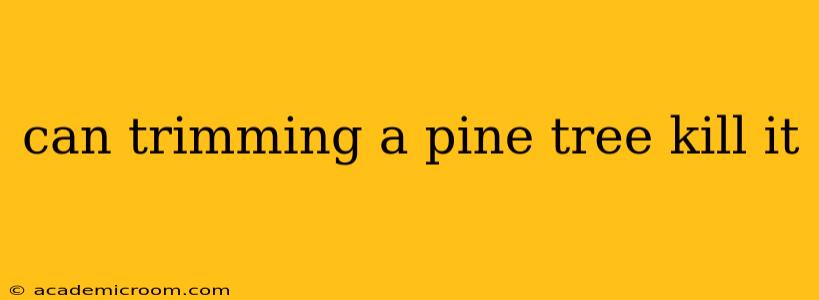Pine trees, with their majestic presence and evergreen foliage, are a beloved addition to many landscapes. However, improper pruning can have devastating consequences, potentially leading to the demise of your prized pine. This comprehensive guide explores the intricacies of pine tree trimming, clarifying what can go wrong and how to prune safely and effectively.
How Much Can You Trim a Pine Tree?
The amount you can trim a pine tree depends heavily on several factors: the species of pine, its age and overall health, and the reason for pruning. Generally, you should avoid removing more than 20-30% of the tree's live crown in a single pruning session. Removing a larger percentage can severely stress the tree, making it vulnerable to disease, pests, and ultimately, death. Remember, pines don't readily produce new growth from old wood, so removing large branches can result in permanent disfigurement.
What Happens if You Cut Too Much Off a Pine Tree?
Over-pruning a pine tree can trigger a cascade of negative effects:
- Reduced Photosynthesis: Leaves are crucial for photosynthesis, the process by which trees create energy. Significant foliage removal drastically reduces the tree's ability to produce energy, weakening it considerably.
- Increased Susceptibility to Disease and Pests: A stressed tree is more vulnerable to diseases and insect infestations. The open wounds left by improper pruning provide entry points for pathogens and pests.
- Sun Scald: Sudden exposure of the inner branches to direct sunlight can cause sunscald, a condition that damages or kills the bark.
- Branch Dieback: The loss of significant branches can cause a dieback effect, where other branches, unable to support themselves or receive sufficient nutrients, begin to die.
- Death: In severe cases, excessive pruning can overwhelm the tree's ability to recover, leading to its death.
Can Trimming the Top of a Pine Tree Kill It?
Trimming the top, or leader, of a pine tree is generally strongly discouraged, particularly for young pines. The leader is the main, central stem that dictates the tree's overall shape and growth. Removing it can seriously damage the tree's structural integrity, leading to multiple leaders, an unbalanced crown, and potential dieback. While some mature pines can tolerate limited leader pruning by experienced arborists, it's best to avoid it entirely unless absolutely necessary (e.g., to remove a damaged or diseased leader).
What are the Signs of Over-Pruned Pine Trees?
Recognizing the signs of an over-pruned pine tree is vital for taking corrective action. Watch for:
- Wilting or browning needles: This indicates stress and lack of sufficient energy production.
- Dieback: Branches starting to brown and die back from the tips.
- Excessive resin flow: An abundance of resin can be a symptom of stress and injury.
- Reduced growth rate: A significantly slower growth rate compared to previous years suggests underlying problems.
- Increased susceptibility to pests and diseases.
How to Properly Prune a Pine Tree
Proper pine tree pruning requires knowledge, skill, and often professional expertise, especially for larger trees. Here are some key points:
- Timing: The best time to prune is usually in late winter or early spring before new growth begins.
- Technique: Use sharp, clean pruning shears or saws to make clean cuts, avoiding ragged edges that can harbor disease.
- Focus on shaping: Rather than removing large quantities of foliage, focus on shaping the tree and removing dead, diseased, or crossing branches.
- Consult a professional: For larger or valuable pine trees, always consult a certified arborist.
Proper pruning is essential for maintaining a healthy and aesthetically pleasing pine tree. By understanding the potential risks of improper pruning and employing the correct techniques, you can ensure the long-term health and beauty of your pines. Remember, prevention is always better than cure. Regular, but minimal, pruning is preferable to aggressive removal of large sections of the tree.
